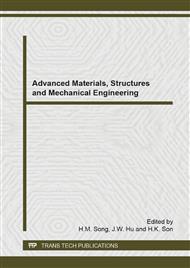p.104
p.112
p.117
p.122
p.128
p.137
p.143
p.148
p.156
Structural Design and Improvement of Wind-Driven Generator Cooling System
Abstract:
With the world’s energy crisis aggravation, the wind turbine technology is undergoing a rapid and continual development all over the world. At present, the increase of the single-system capacity is becoming a major trend of the development of the wind turbine technology, however, how to design a cooling system to keep the whole turbine working in a allowable temperature environment is a critical problem. In this paper, a cooling system of a 3MW wind-driven generator is given and numerical simulation is conducted at 100% load, and then an improvement structure is proposed according to the calculation results. The results show that the windings and stator teeth can be cooled down effectively by the improving method. The improving cooling system removes the over-temperature problem of high temperature zone and allows the temperature of the generator to be less than the limit of 120°C as required.
Info:
Periodical:
Pages:
128-136
Citation:
Online since:
September 2014
Authors:
Price:
Сopyright:
© 2014 Trans Tech Publications Ltd. All Rights Reserved
Share:
Citation:


